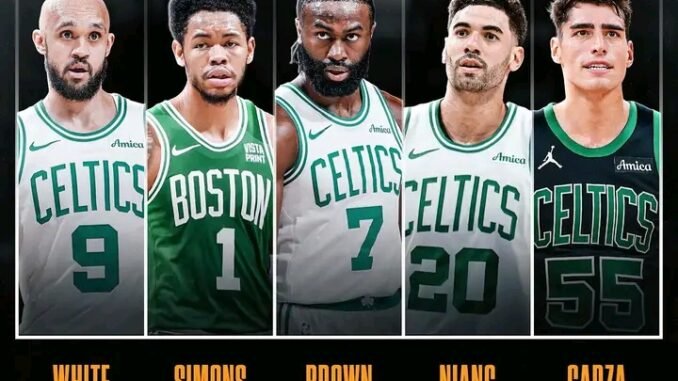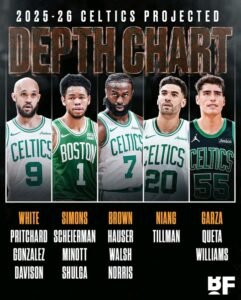
As the NBA landscape continues to evolve, the Boston Celtics are entering the 2026 season as one of the league’s premier powerhouses, with a championship-caliber core and a blend of seasoned stars and rising talent. With Brad Stevens continuing his shrewd front office decisions and head coach Joe Mazzulla gaining experience and respect across the league, the Celtics look poised to extend their dominance into the latter half of the decade. Here’s a deep dive into the projected roster, depth chart, and key insights for the 2026 Boston Celtics.
Projected Starting Lineup
PG: Jrue Holiday
Even in his mid-30s, Holiday remains an elite defender and veteran leader. His defensive tenacity, smart shot selection, and unselfish play have made him an essential piece in Boston’s backcourt. The Celtics have managed his minutes well, keeping him fresh for the postseason, where his impact is most critical.
SG: Jaylen Brown
Now in his prime at age 29, Brown has refined his offensive game and matured as a leader. Averaging over 24 points per game in recent seasons, he’s become a reliable second scoring option and continues to guard the opposition’s top perimeter threats. His chemistry with Tatum has reached new heights.
SF: Jayson Tatum
The franchise cornerstone and perennial MVP candidate is now the undisputed face of the Celtics. At 28, Tatum’s scoring, rebounding, and playmaking are at career highs. His leadership and ability to deliver in clutch moments have helped Boston win and contend for multiple championships in the past few seasons.
PF: Kristaps Porziņģis
Porziņģis has reinvented himself in Boston. While health remains a concern, his shot-blocking, floor-spacing, and post presence make him a matchup nightmare. In lineups with Tatum and Brown, he stretches defenses and opens up the paint.
C: Al Horford / New Acquisition (TBD)
Horford is entering what could be his final NBA season, likely in a reduced role. The Celtics are expected to pursue a younger, more athletic big man either via trade or free agency. Names like Isaiah Hartenstein or a younger rim-runner could enter the fray. For now, Horford’s leadership and IQ keep him in the rotation.
Bench and Depth Chart Breakdown
PG: Payton Pritchard / JD Davison
Pritchard remains one of the best spark-plug guards off the bench. His shooting range and energy lift the second unit, and he’s grown more consistent as a floor general. JD Davison, entering year three, shows promise as a defensive guard with elite speed and improved playmaking.

SG: Malcolm Brogdon (if retained) / Rookie Prospect
Brogdon’s status is uncertain due to trade rumors, but if he stays, he provides vital bench scoring and veteran stability. If moved, Boston may look to draft or sign a younger combo guard to develop behind Holiday.
SF: Sam Hauser / Oshae Brissett
Hauser has evolved into a high-level 3-and-D wing, shooting over 40% from deep. His role will increase if the Celtics emphasize spacing and pace. Brissett brings energy, athleticism, and defensive versatility, serving as a matchup tool on both ends.
PF: Xavier Tillman Sr. / Jordan Walsh
Tillman has quietly become a valuable rotational big—tough, smart, and reliable defensively. Walsh, entering his second full season, has shown flashes of brilliance defensively and continues to improve his offensive skill set. His wingspan and hustle are perfect for Boston’s switch-heavy system.
C: Luke Kornet / Free Agent Signing
Kornet remains a deep rotation piece and locker room favorite. While he’s not a nightly contributor, his height and system familiarity give Boston insurance at the 5. Expect the Celtics to be aggressive in adding another center to shore up depth.
Key Storylines for 2026
Tatum and Brown’s Legacy Era
The Celtics’ success in 2026 hinges on their star duo’s continued growth. Both have silenced critics and have become complete two-way stars. With multiple All-NBA appearances and deep playoff runs, this season may mark their most mature campaign yet.
Managing Veteran Minutes
With Holiday and Horford aging, Joe Mazzulla faces the challenge of keeping them healthy while maintaining competitiveness. Boston’s depth and rotational flexibility will be key to navigating the regular season.
The Youth Movement
Jordan Walsh, JD Davison, and other younger players will be given chances to shine. The front office is clearly preparing for the future, allowing these young talents to develop under a winning culture while still contributing meaningfully.
Trade Flexibility
Boston still has tradeable contracts and future assets. If the season trends positively but with clear gaps (such as a reliable big man or another shooter), expect Stevens to be active at the deadline. Malcolm Brogdon, for instance, remains a key trade piece.
Defensive Identity
Even as the league tilts toward offense, the Celtics’ defense remains elite. With Holiday, Brown, Tatum, Tillman, and Walsh, Boston can switch almost every position and clamp down in late-game scenarios.
Outlook and Expectations
After back-to-back Eastern Conference Finals appearances and a title win in either 2024 or 2025, expectations for the 2026 Celtics are sky-high. This team blends championship experience with fresh legs and tactical adaptability. With Jayson Tatum likely in the MVP conversation again and a defensive ceiling few can match, the Celtics are legitimate contenders.
Barring injury or chemistry setbacks, Boston should finish as a top-3 seed in the East, with eyes firmly set on Banner 19. The only real threats? A resurgent Milwaukee, the ever-dangerous Nuggets, or a surprise upstart squad. But with Tatum and Brown leading the way, Boston’s championship window is wide open—and they know it.
Leave a Reply